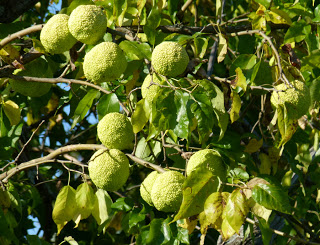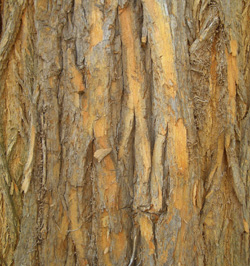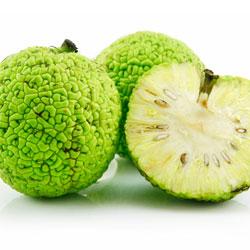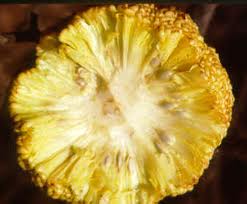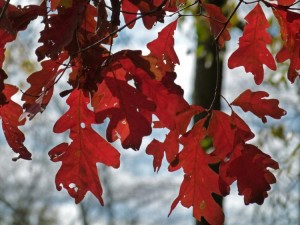During these bright autumn days, you might notice a peculiar looking tree growing along the roadside. It looks like bright green oranges or softballs are hanging from its branches! Maclura pomifera, commonly called Osage-orange, hedge-apple, Horse-apple, Bois D’Arc, or Bodark (take your pick), is a small deciduous tree or large shrub, typically growing to 26–49 ft. tall. It is dioeceous, that is, having male and female flowers on different plants. The fruit, a multiple fruit, is roughly spherical, but bumpy and it is filled with a sticky white latex sap. In fall, its color turns a bright yellow-green and it has a faint odor similar to that of oranges. It is not closely related to the citrus fruit called an orange: Maclura belongs to the mulberry family, Moraceae, while oranges belong to the family Rutaceae.
The Osage-orange is native to a small area in eastern Texas, southeastern Oklahoma, and southwestern Arkansas. This region is the home of the Osage Indians which gives the tree its common name. Settlers found that the Osage-orange transplanted easily, tolerated poor soils, extreme heat, and strong winds and had no serious insect or disease problems. It was widely planted in the Midwest as a living fence because, when pruned into a hedge, it provided an impenetrable barrier to livestock. The development of barbed wire curtailed its widespread planting, but many Osage-orange trees can still be found in fence rows. The wood is extremely hard, heavy, durable and shrinks or swells little compared to the wood of other trees. The wood is used for fence posts, treenails, furniture, and archery bows. In fact, many archers consider the wood of the Osage-orange to be the world’s finest wood for bows. Another common name for this tree, bodark, is from the French bios d’arc meaning “bow wood.” This tree also produces a bright yellow dye which can be extracted from the wood.
The fruit of the Osage-orange is a nuisance in the home landscape and has little value. Hedge apples are not an important source of food for wildlife as most birds and animals find the fruit unpalatable. The thorny trees do provide nesting and cover for wildlife. The belief about the use of hedge apples for insect control is widespread and persistent. it is claimed that placing hedge apples around the foundation or inside the basement will repel or control insects. A few years ago, Iowa State University toxicologists extracted compounds from hedge apples. When concentrated, these compounds were found to repel insects. Scientists also found that natural concentrations of these compounds in the fruit were too low to be an effective repellent. So, don’t be fooled into spending much to use hedge apples as an insect repellent. If you decide to pick hedge apples to check out the repellency yourself or to use the fruit as a fall decoration, it would be wise to wear gloves. The milky juice present in the stems and fruit of the Osage-orange can irritate the skin.
Is there any use for hedge apples, other than playing softball that is? Unfortunately, the seeds are a bit difficult to extract. This is why squirrels make such a huge mess in your yard while they are eating. To get the seeds, first wash your hedge apple. Next, cut your hedge apple into slices. Inside of the hedge apple, you will find stringy flesh that you cannot eat in the center. This flesh will be surrounded by hundreds of tiny seeds that look similar sesame seeds. The seeds will be trapped in a very sticky substance inside the husk. You need to remove the seeds from the fleshy part of the apple, then wash away all of the slime. Next, dry your seeds and remove them from their tiny husks. Your hedge apples can now be roasted, just like sesame seeds. You can roast them dry or toss them in some olive oil first. When this is done, you can use the hedge apple seeds in any recipe that calls for sesame seeds. They can be used to top rolls or breads, or spread over a salad if you want to give it a slight crunch.
I think I would prefer softball. By the way, don’t let one hit you in the head – it hurts!

